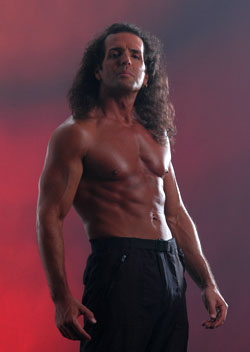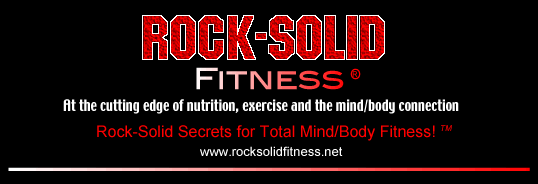|

The Exercise Philosophy
 |
The ultimate way to Rock-Solid physical conditioning is through the A.R.C. This is a three-tiered approach that stands for: Aerobic training - for cardiovascular fitness;
Resistance training - for muscular development and bone health, and;
Core/flexibility training - for balance, flexibility and the development of the many smaller muscles, tendons, etc., that are often missed in traditional exercise programs. |
For
now, let's focus on some resistance training concepts. Here's an excerpt
from the book that will ensure that you continue to make progress with
your weight training efforts:
F.I.B.E.R.:
Getting Optimal Results From Resistance Training
F.I.B.E.R. is an easy-to-remember acronym that represents five of the most important components to resistance training. By giving your attention and effort to any or all of these concepts, you will always make progress with your program.
F.I.B.E.R.
stands for: Form and Focus, Intensity, Balance, Exercise variety and
Rest.
F = Form and Focus: Okay, so we've doubled up on this first one, but only because they are so interrelated.
Form has to do with how correctly you are performing a movement. For example, does your back remain straight during your squats, or do you have a tendency to hunch over? Are your elbows anchored during your tricep pushdowns, or do they swing up a bit at the top of the movement? Incorrect form is almost epidemic in many gyms, either because someone's trying to do too much weight or because they were never really instructed as to the right way to perform an exercise.
The downside to improper form is two-fold:
1) You are not training the particular muscle group as efficiently as you could be, and;
2) You can often be risking injury to the various muscles, tendons and ligaments involved with the incorrect movement.
Granted, when you really zero in on proper form, you often have to lower the amount of weight you're lifting, and this can be a difficult psychological thing for many people. No worries. The weight will not only come back, but it will often eventually increase because you wind up recruiting even more of the actual muscle fiber involved when you use proper form.
Once
your form is in tact, Focus has to do with getting
your mind totally involved with the movement. When performing lat pulldowns,
for instance, we oftentimes just jump on the machine and start lowering
and raising the bar without much conscious thought as to which muscle
groups we are specifically using to make it happen. Instead, for a really
focused effort, you would envision your hands as "hooks" around
the bar, align your torso in proper form, then concentrate on pulling
the bar down from your back muscles, as opposed to your biceps. This
slight mental distinction does wonders to recruit more of the muscles
that you are actually trying to work and, as a result, you will feel
more of a burn. This lets you know that your power of focus is giving
you a more effective workout.
I = Intensity: The body has a way of adapting to various workloads. So if you want to continue to get results from your training, you must train with enough intensity so that you experience some degree of that post-workout soreness. This usually requires a conscious effort.
For
example, when you first start training, you might find that doing three
sets of 12-rep curls with 20-pound dumbbells will make you sore. But
once your body adapts to all of those particulars, you will no longer
get sore, so you'll want to bring in a few intensity concepts and techniques.
This will keep your body from developing an immunity to a set routine,
which will ensure continuous progress with your training.
|
Give Me Some Intensity! Here are a few ways to increase the intensity of your weight training workout:
|
B = Balance: This is all about being mindful of the symmetry of your body and making an effort to keep everything in balance, relative to everything else. We do this for both aesthetics and safety/efficiency.
Where aesthetics, or visuals, are concerned, this is where the artful side of resistance training comes into play. Is there balance between your biceps and triceps, or is one over or under-developed? Do you have excellent chest development, but a neglected back? Is your upper body developed to one extent, but your legs lagging behind? (This one is particularly common among many novice weightlifters or bodybuilders who don't enjoy working their legs as much as the more "popular" upper body.) All of these things will be a factor as to how symmetrical your body looks.
From a safety/efficiency perspective, balance has to do with making sure that each muscle group is roughly at the same level of development as the opposing group or related group. Examples of this include the quadriceps, which are at the front of your thighs and your hamstrings, which are at the back. If your hams have fallen behind relative to your quads and you try to go heavy on a squat or leg press movement (which ultimately employs both), you risk injury in either the quads, because they are trying to compensate for the weakness in the hams, or in the hams, because they are being overloaded. Same with the three heads of your deltoids. If your rear delts continue to be ignored (as they so often are), then your front or middle delts will have to compensate on certain movements and can eventually get overloaded or overused, thus subject to injury.
So
always strive for balance in your physique...even with your least favorite
bodyparts to train.
E = Exercise Variety: This principle has to do with mixing things up in your workouts and making sure that you get a lot of variation in your choice of exercises. We do this for a couple reasons:
1) As discussed in the Intensity section, the body has a way of adapting to a set routine, thus stifling your opportunity for continual results. In addition to some of the Intensity techniques we discussed, an excellent way to ensure that the body cannot adapt to a particular program is simply to switch up the exercises you do from time to time. If you've had a few workouts in a row where you've done flat bench barbell presses as a primary chest movement, perhaps you would try an incline dumbbell movement for a session or two just to keep the body guessing. Or, if you've been training your biceps with several different machines for awhile, maybe you would try a bicep workout that consisted exclusively of free weights. Variety of any kind is key here.
2)
As we engage in this variety of exercises, there are subtle differences
in how we stimulate the various muscle groups. One-arm dumbbell rows
from a bench hit the lats a certain way, while close-grip lateral rows
with a cable hits them another way. It's the same muscle group, but
you're attacking it from a "different angle," if you will.
By bringing in this concept of variety to your routines, you will experience
a fuller, more detailed development.
R = Rest: The final part of F.I.B.E.R. is rest and it breaks down into two areas.
1) Make sure you are getting the quality and quantity of rest every day, even if it means squeezing in a "power nap" from time to time. This is a critical component to the recuperation process between workouts and is, essentially, when the actual results of your training crystallize.
2) Make sure you take plenty of time off between working a particular body part. Contrary to the workout philosophies of many overzealous and beginning weightlifters, you've got to rest a body part a minimum of 48 hours before working it again. And this is during light training. If you're really hitting it hard, you will want to take three, four or even five days off before hitting a particular body part again. (I've made my most dramatic gains on a regimen that involved working each muscle group every fifth day.)
Your main barometer is soreness. If you are still feeling even a little soreness in a given muscle group that you're wanting to train, I say give it an extra day.
Keep hitting it hard, and be sure to try all of these F.I.B.E.R. concepts in your training regimen.
Home - Nutrition - Exercise - Mind/Body - Fitness Links - About Bobby Rock
© 2001 - 2008 Bobby Rock









